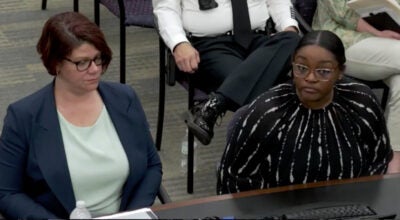Otto Wood's legend becomes play
Published 12:00 am Monday, June 13, 2011
By Mark Wineka
mwineka@salisburypost.com
NORTH WILKESBORO — Waiting for the start of the stage play, “Otto Wood: The Bandit,” Bobby Spencer said we should have a contest.
By the end of the night, Spencer challenged, come up with the one, best word to describe our experience.
The game was on. The venue — The Record Park at Fourth and E streets — already had grabbed the attention of the traveling Salisbury foursome I was a part of.
It was rustic — an outdoor amphitheater of sorts built after fire had destroyed the weekly “Record” newspaper office in 2004. The audience sat under a tall shelter, capped with a metal roof. The floor was a mix of grass, gravel and stones, and lines of metal folding chairs provided the seating.
The audience faced two modest stages, which could pass for farm outbuildings from a distance. They had metal roofs, too, and floodlights on the ceiling pushed light onto the performance areas, which were built more for musical acts than full-scale stage productions.
In fact, three music festivals are held here every year, utilizing the Sammy Lankford Stage and the smaller Tut Taylor Spotlight Stage.
Our bluegrass musicians for the night made their home on the spotlight stage, playing the transitions between scenes and setting the whole evening up with a beautiful version of the 1931 ballad that helped in keeping Otto Wood’s legend alive.
The more this first-ever production of “Otto Wood: The Bandit” unfolded, the more you appreciated the setting.
A dog’s bark in the distance. A small airplane overhead. Lightning bugs blinking among the actors and audience. A fence advertisement for Wilkes Hardware. A half-moon in the sky. An old bathtub filled with colorful flowers. A lone portable outhouse on the hill.
It all fit with Record Editor Jerry Lankford’s early 20th century story about Otto Wood, the notorious Wilkes County criminal killed in a New Year’s Eve gunfight on the streets of Salisbury in 1930.
That’s why we were here. In recent years, Bobby and Betty Dan Spencer had become fascinated with Wood’s story as part of Betty Dan’s historical research. They had traveled to Coaldale, W.Va., to see Otto Wood’s grave marker. Some years back, I had tagged along with the Spencers and Wayne Whitman to visit one of Wood’s surviving relatives, an old moonshiner in Wilkes County.
Betty Dan wrote the succinct text for the Otto Wood marker on East Innes Street (in front of the old Hardiman Furniture Building), which is part of the city’s History and Art Trail.
It was near this building that Salisbury Police Chief R.L. Rankin fatally wounded Wood in a gunfight that sprayed some 11 bullets after Wood was confronted by Rankin and Assistant Chief J.W. Kesler.
Lankford’s play, of course, builds to that Salisbury scene.
Thousands viewed Wood’s body at Wright’s Funeral Home in Salisbury before citizens donated money for the shipment of his remains to his mother, Ellen Wood, in West Virginia. Mother and son are buried side by side in Coaldale.
Over his life of crime, Wood escaped Central Prison an amazing four times. The last time he was in the Raleigh prison, Wood was serving a murder sentence for killing Greensboro pawnbroker A.W. Kaplan.
The “Otto Wood” stage play is one of the more complete life stories you’ll find of a bandit from this era. Lankford relied on an autobiography Wood wrote during one of his stays in prison and interviews he conducted with Wilkes County people who remembered Wood or had heard stories passed down about him.
Nat Padgett, the actor who plays Wood, relays much of the autobiographical background in several scenes in which he is telling his life’s story to Warden Norman, played by Director Heather Osborne.
Padgett carries the show with his solid performance. Scene stealers include Daniel Hilton as a young Otto Wood, Kathy Moffett as Ellen Wood and Evan Anderson as a nervous deputy confronting the “one-armed bandit.”
Wood, 36 when he died, lost his left hand in a hunting accident and walked with a limp — things Padgett incorporated into his portrayal.
Lankford and Osborne also used a multi-media approach. For the courtroom scene where Wood is found guilty of killing Kaplan and for his last escape from Central Prison, they turned to 20-year-old filmmaker Jared Shumate.
After intermission, the audience sees these two purposely grainy, black-and-white scenes on a pull-down movie screen. It’s a nice touch.
Lankford spent the whole production playing guitar with the musicians.
“I haven’t really gotten to see it,” he said after the show when Betty Dan and I had a chance to speak with him. He was bushed, dead tired from all the preparations and practices.
Betty Dan asked Lankford when “Otto Wood: The Bandit” would play in Salisbury.
“Let us know,” Lankford said. “We’ll pack it up and bring it down there.”
On the way home, I revealed my one word to sum up the evening.
“Homespun,” I said.
This seemed to satisfy everyone in the car until Bobby Spencer weighed in.
His word: “Outstanding.”
“I thought it was well done,” he said.
Bobby won the challenge.
Contact Mark Wineka at 704-797-4263, or mwineka@salisburypost.com.
‘Otto Wood: The Bandit’
What: Stage play, written by Jerry Lankford, on the life (and death) of Wilkes County criminal Otto Wood.
When: 7:30 p.m. Friday and Saturday
Where: The Record Park, corner of Fourth and E streets, North Wilkesboro.
Price: $5
Background: Salisbury Police Chief R.L. Rankin fatally wounded Otto Wood in a shootout on East Innes Street on New Year’s Eve, 1930.
More information: Contact The Record newspaper at 336-667-0134, or www.the
recordofwilkes.com.



